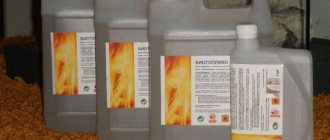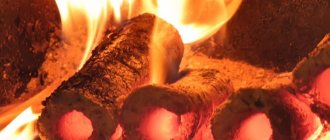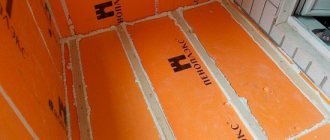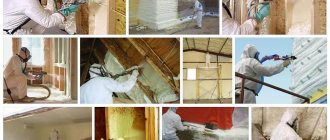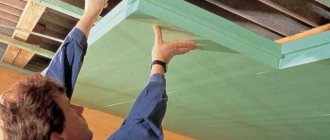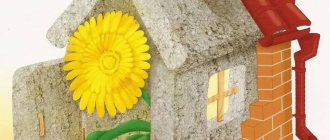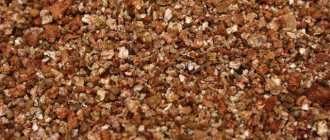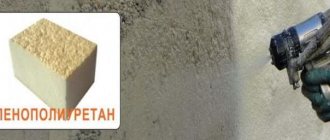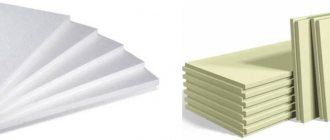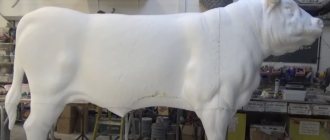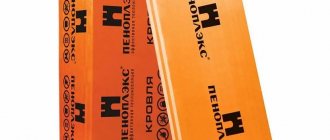The abundance of materials for thermal insulation allows you to choose the best option for each specific case. Along with slab insulation, expanded clay is also often used. This material attracts not only its reasonable cost, but also its environmental friendliness. The versatility of expanded clay allows it to be used for floors, roofs or foundations, but most often it is used for thermal insulation of walls.
Well masonry with expanded clay layer
Expanded clay production technologies
Thermal insulation material is obtained by firing low-melting clay. Under the influence of temperature, swelling occurs and the fractions acquire a porous structure, due to which heat is retained. At the same time, the outer shell is quite strong, which makes it possible to withstand natural influences. Strength characteristics depend on the chosen production method, as well as on the accuracy of the technology. The most common manufacturing methods are:
- plastic;
- wet;
- dry;
- powder-plastic.
Expanded clay production scheme
The most common is the plastic method, the essence of which is to moisten the material. Next, it is dried and granules are formed. The popularity of this method is due to the fact that the result is expanded clay with high quality characteristics.
The wet method is used when the source material has many rocky inclusions, since it allows the raw material to be purified. It is also rational to use this method if the clay is too wet. The dry method is used to work with stone-like raw materials. It is important to use it in cases where the source material has a minimum of harmful impurities.
The powder-plastic method is quite expensive, since it involves preliminary grinding of raw materials, moistening, and then heat treatment. From the resulting plastic mass it is necessary to form granules of the same size, as this affects the final parameters of expanded clay.
To give the material additional characteristics and increase its strength, various impurities are added to the composition. They can be of both organic and inorganic origin. After firing, the granules are cooled and then crushed into fractions of the required size.
Expanded clay production process
What is expanded clay?
Expanded clay is small granules of light weight due to small pores that are obtained as a result of clay firing. Thus, the result is a completely environmentally friendly natural material that has good technical indicators, such as:
- noise insulation - dampens shocks; thermal insulation - retains heat well; frost resistance - does not collapse at low temperatures; fire resistance - is not exposed to fire; strength - does not change its structure under the influence of cold/hot water; durability - does not change its properties under the influence of high/low temperatures temperatures, lasts longer than other insulation materials.
Equipment for the production of expanded clay
If we compare expanded clay with other thermal insulation materials, it significantly benefits in terms of service life. In addition, expanded clay is much cheaper than other thermal insulation materials in this category.
But the most important property of this material is that, for example, pouring a floor with expanded clay is an excellent option when building your own home.
Disadvantages of wall insulation with expanded clay
Expanded clay has certain disadvantages, which is why some people refuse to use it, since if installed incorrectly, all the shortcomings are clearly visible and can negatively affect the result of insulation:
- High level of moisture absorption . In the absence of a special protective crust on the granules, moisture is absorbed quite actively. In this case, drying takes quite a long time. The presence of a hygroscopic layer will help solve this problem.
- Increased dust formation . When insulating the facade, it is recommended to use a respirator.
- Reducing usable area . In order for the thermal insulation to be of high quality, it is necessary to lay expanded clay in a thick layer, which can “eat up” part of the room.
- Fragility of granules , due to which mechanical damage is possible during compaction, which leads to deterioration in thermal insulation characteristics.
- The need to use a sealant when insulating to prevent shrinkage and exposure of parts of the wall. This is due to the friability of expanded clay.
Insulating walls with expanded clay has both its advantages and disadvantages.
However, by strictly following the laying technology and purchasing high-quality expanded clay, you can avoid unpleasant moments.
Main characteristics of the material
Experienced builders know everything about the positive properties of expanded clay:
- high level of thermal insulation;
- strength and durability;
- resistance to cold and frost;
- reliable absorption of liquids;
- Fire safety;
- naturalness and environmental friendliness, this is especially important in a wooden house;
- Expanded clay insulation is chemically inert and resistant to acid attack ;
- The capabilities of the material significantly exceed the cost.
However, the pros and cons must be considered comprehensively so that the choice of thermal insulation is made rationally. The disadvantages of expanded clay usually include long drying time when exposed to moisture, as well as its tendency to form dust . Despite all the environmental friendliness, this material is not hypoallergenic. It’s not for nothing that builders who work with expanded clay wear a protective respirator. Expanded clay as an insulation material is very popular in construction, and if the substance remains after thermal insulation work, it is used for floor screed, reducing foundation depth, preparing expanded clay concrete, carrying out drainage work or garden landscaping .
Positive reviews about expanded clay are mainly related to its low cost, durability and decorative properties. Negative reviews are based on the properties of the hard ceramic crust around the porous core: what is good for hydroponics is not entirely appropriate for thermal insulation. Due to its hard coating, expanded clay absorbs water well, but does not release it well . Experienced craftsmen know that expanded clay as insulation in granules is simply poured in, without concreting. Crushed stone and sand from clay can be added to building mixtures.
Useful: Frame garage: step-by-step construction instructions
Advantages of expanded clay as insulation
The use of expanded clay for insulation allows you to create a comfortable atmosphere in the house and retain heat as much as possible. In addition, the material has the following advantages:
- Durability. The natural origin of the insulation has endowed it with high strength.
- Safety. Expanded clay is an environmentally friendly material and therefore does not harm the health of residents.
- High level of sound insulation.
- Resistance to damage by rodents , as well as resistance to pathogens, fungus, and rot.
- Fire safety . Thanks to the pores inside the granules, expanded clay is not afraid of fire and sudden temperature changes.
- Easy to install . Laying is carried out without the use of additional equipment. If you have basic construction skills and strictly follow the technology, it is possible to carry out the procedure yourself.
Different types of expanded clay
Insulating indoor walls with expanded clay has obvious advantages, but only if high-quality material is used, as well as strict adherence to installation rules.
Roof insulation with penoplex
Due to its unpretentiousness, penoplex can be used in different conditions. Click on photo to enlarge.
- Low moisture permeability.
- Resistance to strong temperature changes.
- Biological neutrality.
- Resistant to fire and high temperatures.
- High heat and noise insulation coefficients.
- Environmentally friendly, non-toxic, safe for human health.
All this makes penoplex a sought-after and popular material for roof insulation. Penoplex is easy to install and can be cut with a regular knife. At the same time, it is resistant to mechanical loads and is lightweight, which makes it popular for insulating floors and flat roofs in use.
Penoplex slabs are made from high quality polystyrene foam by extrusion. During the production process, sealed air cavities are formed in the raw materials.
After hardening, penoplex acquires a homogeneous cellular structure. Thanks to it, the material has high thermal insulation characteristics, as well as mechanical strength.
Where can Penoplex be used?
Extruded polystyrene foam is allowed for use in any climatic zones.
Its use can significantly reduce the cost of materials during construction and the further operation of the building. After all, a five-centimeter layer of penoplex is not inferior in characteristics to brickwork, 153 mm thick.
Roof insulation with penoplex can be done using any type of material. Most often you can find the following types of extruded polystyrene foam on sale:
- Penoplex 31 Standard.
- Penoplex 35.
- Penoplex 45.
To insulate the roof in a private house, Penoplex 35 is most often used. It perfectly protects the roof waterproofing from sudden temperature changes and other destructive factors.
It is used to insulate a pitched roof from the inside of an attic or flat roof using the “rolling ceiling” method. In the second case, a covering of gravel or paving slabs is made on top of the insulation on the roof. This will help protect the material from the wind and increase the fire safety of the roof.
Types and quality of expanded clay: which one to choose?
Thermal insulation technology, first of all, depends on the selected type of insulation. Expanded clay is presented on the construction market in the form of gravel, sand and crushed stone. Each type has a different fraction size and varies from 2 to 40 mm.
Gravel
Expanded clay gravel
has the largest grains . In turn, it is divided into three types:
- 5-10 mm;
- 10-20 mm;
- 20-40 mm.
The level of thermal insulation depends directly on the size of the fraction, so to use large expanded clay for wall insulation Expanded clay gravel is used not only for thermal insulation of floors, but also for heating mains.
Sand
Expanded clay fine fraction
In this case, the fractions have minimal sizes - up to 5 mm . It is rational to use such expanded clay for insulating interior partitions and floors. In addition, expanded clay sand is often used as a filler in the production of ultra-light concrete. It is important to use this particular type in order to reduce the weight of the finished structure.
Crushed stone
Formed by grinding expanded clay gravel . Together with other types it is used in the production of lightweight concrete. As for the thermal insulation characteristics, they are lower than those of gravel.
Thermal conductivity of polystyrene foam, comparison with other materials
Expanded polystyrene (EPS) is a popular insulation material. The material is produced by extrusion, which provides it with high performance qualities. The main advantage is low thermal conductivity, which allows you to retain heat inside the room, optimizing heating costs.
Important advantages of this material also include:
- High strength.
- Ease of processing.
- Ease of installation.
- Light weight.
- Waterproofing properties.
- Environmentally friendly.
- Durability.
- Reasonable price.
Expanded polystyrene is suitable for insulating the facade of low-rise buildings made of brick, cinder block, reinforced concrete slabs, etc. The thermal conductivity coefficient of expanded polystyrene is the amount of thermal energy transferred from the warm section of the building structure to the cold one, and the smaller it is, the better it retains heat inside the room.
What does the thermal conductivity of PPS depend on, comparison with polystyrene foam
Extruded polystyrene foam is a material with low thermal conductivity, which is due to its porous structure, which helps conserve thermal energy. The production technology is based on mixing granules at high temperatures, followed by pressing, resulting in a fairly dense material with a closed porous structure and small granules. At the same time, the thermal conductivity of polystyrene foam made by extrusion is 00.028–0.034 W/(m K). This figure is significantly lower than that of other insulation materials.
In general, thermal conductivity depends on the density of the material. Compared to the thermal conductivity coefficient of polystyrene foam, it is lower for polystyrene foam. Moreover, its density is significantly higher (100 kg/m3) than that of foam plastic (30 kg/m3). This is also due to the fact that the cells of the foam plastic are filled with gas, while in PPS they are filled with air, which does not evaporate and, accordingly, retains thermal energy inside itself, regardless of climatic conditions.
Low thermal conductivity is also associated with its structure. It has a small volume of solid matter, less than three percent. The cell sizes vary from 0.1 to 0.2 mm, and the granule sizes are correspondingly smaller. And the smaller and more uniform they are, the higher the quality indicators of the material.
This is due to the production technology; in the case of polystyrene foam, it is based on the joining of granules due to thermal expansion (the feedstock is processed with dry steam). The result is a material with heterogeneous cells and large granules that are not very tightly bonded to each other.
That is why polystyrene foam is significantly inferior in strength, and therefore can transmit heat. Although in recent years, manufacturers have been offering foam plastic made using the extrusion method, which in terms of density (30, 50 kg/m3) and thermal conductivity (about 0.002 W/(m K)) is not far behind PPS.
In general, the thermal conductivity of polystyrene foam, although slightly, can vary depending on the grade of material, which is determined by the manufacturing technology:
- Pressless.
- Pressed.
- Extrusion.
- Autoclave.
- Autoclave extrusion.
Each type differs in density, with the lowest thermal conductivity of polystyrene foam, the specific weight of which is about 30 kg/m3, but on average this indicator varies between 0.031 - 0.035 W/m·K.
Thermal conductivity coefficient and plate thickness
Manufacturers offer PPS boards with a thickness of 10–200 mm. But this indicator has little effect on the thermal conductivity coefficient. For sheets up to 30 mm thick, this figure is up to 0.035 W/(m K); they are used for thermal insulation of interior partitions.
PPS up to 100 mm thick has a lower thermal conductivity of 0.3–0.031 W/(m K), they are used to insulate facades and interior walls to reduce heating costs. Samples with a thickness of 100 mm or more have a thermal conductivity of 0.31-0.32 W/(m K), their use is most effective in harsh climatic conditions for thermal insulation of the foundation.
Selection of insulation, thermal engineering calculation
The thermal conductivity of insulation is the main indicator when organizing work on thermal insulation of a room. To achieve the desired effect, a thermal engineering calculation is carried out, taking into account the purpose of the room, the design of the building, the climatic conditions of the region and other features.
For insulation of foundations, basements, floors and ceilings, polystyrene foam with a thermal conductivity of 0.033 - 0.038 W/m·K is used. Samples with indicators of 0.037 W/m·K are used for insulating facades.
The influence of various factors on the thermal conductivity of PPS
Practice shows that during operation the thermal conductivity value may deteriorate. For example, insulation loses its effectiveness when used for a long time at high temperatures (the maximum allowable value is 80 degrees).
A change in the structure, and, accordingly, a deterioration in thermal insulation qualities is observed due to prolonged exposure to direct sunlight. Therefore, after installing polystyrene foam, it is necessary to finish the EPS boards using plaster or siding.
But the last, no less important requirement for ensuring effective thermal insulation using EPS boards is compliance with all technological rules when installing them, otherwise polystyrene foam of even the lowest thermal conductivity cannot provide the desired result.
How to count expanded clay?
Before you begin insulation, it is important to calculate the amount of expanded clay needed. The required thickness of the insulation layer will depend on:
- characteristics of thermal insulation material;
- climatic features of the region;
- wall material.
When thermally insulating walls or insulating the foundation, you should take into account:
- thermal conductivity: for expanded clay the indicator is 0.17 W/m * K;
- minimum thickness – 200 mm;
- the ratio of the wall thickness to the thermal conductivity coefficient of the material from which it is made, the so-called thermal resistance.
Next, a calculation is made depending on the surface area that should be insulated. Experts recommend entrusting this process to professionals, but today there are special online calculators that allow you to carry out the calculations yourself.
Where is it used?
When installing the floor. Oddly enough, expanded clay as an insulation material is an almost ideal material.
For example, you want to insulate the floor in your home as much as possible, but installing a heated floor makes a significant hole in the family budget. Then expanded clay can become a good insulation material. And depending on the type of floor base, methods of insulation with expanded clay are selected.
Using expanded clay for flooring
So, for reinforced concrete floors, there is the following method: first, a vapor barrier material is placed on the slab (an ordinary thick film will do), which protects the material from moisture, then expanded clay concrete mortar is poured/poured onto the film. Thanks to the combination of expanded clay with a concrete mixture, it is possible to reduce the coefficient of thermal conductivity of the floor, which, in turn, means an increase in the thermal insulation qualities of the insulated floor.
If the house has wooden floors, then insulation is carried out as follows: a vapor barrier film is laid on the wooden floor, dry expanded clay is poured onto the film, and the expanded clay layer is covered with floorboards on top. In this case, not only does heat loss decrease, but even mice will not live in such a floor!
When laying the foundation.
In this case, insulation can be performed both externally and internally. When insulating the foundation from the outside, you should fill the hollow space under the blind area from the street, but if you are insulating the inside, then you need to fill the void under the ceiling of the first floor. By acting in this way, you can reduce the depth of the foundation, thereby increasing the thermal characteristics of your floor.
Important! In both cases, it should be remembered that expanded clay must be protected from moisture with good waterproofing.
When constructing walls. As you know, the easiest way is to insulate newly erected walls with expanded clay - using the three-layer masonry method: the load-bearing layer consists of expanded clay concrete blocks (20-40 cm thick), the main layer is capsimet (a solution of cement milk and expanded clay), the third layer is protective, for which panel slabs, bricks for cladding, and even wood are used.
Roof insulation with expanded clay
When installing roofs and attics.
If you want to turn your attic into a warm attic, then you can also use expanded clay for insulation - it has the quality of being light weight (which is a very important indicator when constructing an attic, and also significantly affects the load of the foundation). A waterproofing material is laid on the base of the attic floor, onto which expanded clay is subsequently poured. You can then walk on expanded clay.
But when installing a roof, there is a slightly different method: first, a void space is prepared (the void is created by constructing the internal and external sheathing), a vapor barrier film is laid on the sheathing, the void of which is filled with expanded clay.
For thermal insulation of soil. As a rule, such work is only needed in gardening work, when it is necessary to “insulate” the soil for seedlings, etc.
Technology for insulating a brick wall with expanded clay
The most common use of expanded clay is in three-layer structures. The fractions are poured into the frame, so it is important to understand that the insulation process should take place precisely at the stage of wall construction. There are 3 main methods of thermal insulation.
Lightweight well masonry
Lightweight well masonry
A structure is constructed from two rows of bricks, the space between which is filled with a heat insulator. This happens as the wall is being built. When falling asleep, compaction occurs. In order to prevent subsidence, a special cement mortar is used to bind the fractions. It is important to tie every 1-2 rows of bricks using jumpers. The distance between the rows should be approximately 15-30 cm. However, this parameter can be increased, especially for cold regions.
Well masonry with stiffening diaphragms
Transverse diaphragms in well masonry
With this technology, a frame is also constructed, and the outer wall can be made not only of brick, but also of concrete or ceramic blocks. The heat insulator is filled in after 5 rows of masonry. Compaction and filling with cement laitance takes place. After this, the stiffness diaphragm is laid out. It is laid over the entire thickness of the wall, so in the future, when the expanded clay shrinks, it will be impossible to get inside and add insulation. This is the only drawback of the described technology. As for the advantages, this design allows you to add rigidity to the height, while avoiding the use of anchors for dressing.
Masonry with embedded parts
Anchoring brickwork with steel rods
The process is similar to lightweight masonry, the only difference is the use of anchors . They can be either metal or metal-plastic. With this method, the consumption of bricks is reduced, while the strength characteristics of the structure remain high. The optimal gap for backfilling is 30-50 cm. It is at this distance that it is easier to tamp and fill with cement mortar.
Advantages and disadvantages
The high popularity of expanded clay among consumers, in the presence of a large assortment of modern insulation materials, is explained by its strengths :
- low price - one of the most powerful arguments when choosing the type of thermal insulation material;
- good thermal insulation properties;
- durability - subject to operating conditions, the material does not lose its original characteristics for 40-60 years;
- fire resistance - belongs to the class of non-combustible materials (NG);
- resistance to temperature changes - at the household level it is impossible to create conditions under which insulation granules begin to collapse, i.e. tolerate any frost and fire;
- high frost resistance - withstands up to 300 freezing/thawing cycles;
- light weight - does not create mechanical loads on floor slabs;
- the ability to be used in cement mortars, which, firstly, lightens the weight of the screed or blocks, and secondly, improves the thermal protection of the room;
- high level of sound insulation;
- strength;
- environmental safety - the product contains no allergens, no harmful substances are released when heated;
- biological resistance - does not serve as a basis for the proliferation of fungus and mold, mice and rats avoid settling near the material - can be sprinkled;
- simple, yet convenient installation - no experience in performing thermal insulation work is required; thanks to its flowability, any difficult area can be filled.
The above advantages of expanded clay require comments and clarification.
- The list of benefits is compiled based on the opinions of experts and consumers.
- The experience of the StroyGuru website employees in the construction industry makes it possible to question some of the experts’ statements.
Let's start with something simple.
1. Is expanded clay an insulation material? The thermal conductivity coefficient of expanded clay granules varies from 0.1 to 0.18 W/(m×°K). The specific value depends on the size of the pellets and bulk density. Based on the fact that a mixture of fractions is used for insulation, the actual thermal conductivity is in the range of 0.14-0.15 W/(m×°K). This means that a 5-centimeter layer of SPB-25 foam insulation corresponds to a layer of expanded clay 15 cm thick, and mineral wool - 12 cm. Conclusion: expanded clay can be classified as insulation, but with low efficiency.
2. Budget cost. Here consumers and experts compare the price of materials in m3. In this case, ceramic pellets really have an advantage. However, for some reason no one takes into account that expanded clay granules are needed 3-5 times more than other types of insulation. Then all calculations are reversed. For example, to insulate a floor with expanded clay you will have to pay 1.3-3.1 times more than when using polystyrene foam. It seems incredible, but it is true. We suggest that doubtful readers do the calculations themselves.
3. Good sound insulation. Expanded clay, like many other insulation materials, cannot be an effective sound insulator. It has a high modulus of dynamic elasticity - 15 mPa. For comparison: for basalt wool used for sound insulation of recording studios, this figure is only 0.3-0.6 mPa.
4. Light weight. The statement corresponds to the actual weight of the ceramic pellets, but is not tied to the volume of expanded clay that is poured onto the base of the floor. And this is several tons. The floor slab will withstand it, and the rough wooden floor must be made of boards at least 25 mm thick. There is a risk that thinner boards will not withstand mechanical load.
5. Durability. It is not clear what kind of strength we are talking about here. If we are talking about static or dynamic load, then there can be no talk about strength - the material is fragile. It's easy to check: just step on a few granules on the floor slab. However, not everything is clear here either - some of the pellets will not be crushed, but you can walk on a layer of several cm without fear of damaging something. Conclusion: the material is fragile, so during the insulation process you need to walk on the already poured layer.
Technology of wall insulation with expanded clay
In addition to the three main methods, there are others that are used for walls made of other building materials or in cases where the building has already been erected, but external insulation is required.
| Surface type | Insulation option |
| Aerated concrete | When a building has already been erected, it is necessary to build an additional wall from facade material, and fill the resulting gap with insulation. As with any other option, compaction and impregnation are mandatory. Ventilation gaps should also be left to protect against dampness. |
| Frame walls | Here, expanded clay is not an ideal option, since it can cake and leave parts of the surface without thermal insulation. This can be avoided by careful compaction, but this must be done carefully to avoid damage to the frame. |
| Tree | This heat insulator is rarely used for insulating wooden houses, since the wall cannot withstand such a load. To solve this problem, it is necessary to build an additional foundation. From an economic point of view, this is unprofitable. |
In addition to walls, due to the cost-effectiveness of the material, many prefer to insulate floors and attics with expanded clay.
Criteria for choosing expanded clay
It is necessary to choose this insulation based on certain properties and quality. You can judge the characteristics of the material by the markings on the packaging. The bulk density of expanded clay and the brand are usually indicated there.
In addition, when buying insulation, consider the following recommendations:
- Contact either the factory where expanded clay is manufactured or an official representative. Do not purchase goods from dubious sellers, lured by a low price. Its quality can be very low.
Ask the seller to provide quality certificates for the insulation. Expanded clay is manufactured according to GOST 9757-90. Only in accordance with this standard is high-quality clay used and all firing standards are observed.
Pay attention to the conditions in which the material is stored. It should be kept in a warehouse indoors, but not in the open air, where it can become damp and lose its properties.
Check the integrity of the expanded clay fractions. A high-quality heat insulator should have as little broken granules, crumbs, and sand as possible. In general, the volume of spoiled material should be no more than five percent.
Calculating the thickness of insulation for the roof
Ceiling insulation with expanded clay
To insulate the roof, it is best to use expanded clay gravel, since sand is too heavy and crushed stone has sharp edges. The thickness of the insulation in this case will depend on a number of factors:
- architectural features;
- roof shape;
- design.
Calculations are carried out separately for each specific case, but the layer should not be less than 25 cm. In this case, the total thermal insulation layer will be larger, since it is additionally necessary to install a layer of vapor and waterproofing.
The minimum thickness can be increased, but it is necessary to take into account what load the structure can withstand.
The use of expanded clay for the insulation of the roof at home
The scheme expanded clay roof insulation.
You can organize on their own, without the need to hire professionals to do so. Before you insulate it, you need to know what the concrete block and why it is so highly prized for thermal insulation of buildings and structures. Expanded clay is a natural material. It has high strength and can last for a long time, unlike synthetic insulation. At the heart of it - clay. For all these reasons it does not rot, it can withstand very low temperatures, which is especially appreciated in cold climates. It is crumbly and porous structure. Porosity contributes to the conservation of heat. The great advantage of this material is its fire resistance.
Warming of the frequently most performed expanded clay gravel, sand or gravel. In addition to the above, concrete block is a pretty light material, making it easier to carry out works. Today, many plastics are not environmentally friendly, which is not about the concrete block. It is completely safe for humans when operating. Expanded clay waterproof, so do not need to do additional waterproofing layer. Cost of it is low, which is important in the consumer market. In addition, it provides a minimum load on the house and the roof itself. The main disadvantage is its fragility.
The technology of expanded clay roof insulation
Driving a single-layer insulation of the attic.
Before you insulate roofs expanded clay, you need to know some features of this work. In the first place, to obtain good effect when it is advisable to take into account the particular roof insulation of the house, its structure, walls and a sloping roof. Modern (Roof) includes several basic steps: the inner lining, vapor barrier, laying down a layer of insulation and finishing work on the surface (stacking plates or other coating).
is no different from the standard. If there is a reinforced concrete ceiling slabs of the upper floor of the house, the work is somewhat easier.
This will provide a more complete and thorough filling all voids and irregularities. The layer thickness should be 25 cm. clay gravel leveled and compacted. This can be done manually or using a special machine. It is recommended to make a screed on top of the first layer. This construction will give greater strength and rigidity, a flat surface. It is advisable to organize some ventilation ducts between the inner and outer layers to be able to remove excess moisture and ventilation space. On top of the layer of insulation roofing material is placed. It is important that coils overlapping fit and there are no gaps. Above him - shingles or tiles.
List of tools and equipment
Thermal insulation of the roof will require a whole set of tools and materials. It includes: insulation (expanded clay gravel or crushed stone), a shovel, a bucket, a log or stick to ram, rail to align the expanded clay layer, a waterproof film web material (roofing material), Knife, tiles or shingles. Based on the above we can conclude that the insulation of the roof with the help of expanded clay is an effective and simple way. This material is different fire safety, lightness, strength, resistance to low temperatures and humidity, which is especially important for our country. In addition to thermal performance, it is inherent in the soundproofing effect due to the physico-chemical characteristics. It is durable, so found a wide circulation. Expanded clay is used not only to insulate the roof (the roof), it is perfect for warming the floor, hangars, ie all horizontal designs.
Insulating the floor: calculating the thickness of expanded clay
When thermally insulating a floor, it is important to take into account the material from which it is made, since the thickness of the layer will depend on this:
- 40 cm or more – for wood;
- 30 cm – for concrete.
To insulate floors between floors, the layer will be half as large. Also, when calculating the thickness, it is important to take into account the load on the floor. Having decided on the layer, you can calculate the required amount of expanded clay to insulate 1 m². Then the resulting figure should be multiplied by the floor area and you will get the volume of expanded clay that will be required for thermal insulation.
Using expanded clay for insulation allows for significant savings, but this is only possible if all requirements for its installation are met, as well as when using exclusively high-quality material with high thermal insulation properties.
How to insulate the floor in a steam room
Floors in a frame bathhouse are insulated with expanded clay very often, but the high hygroscopicity of the granules requires careful attention to the process. To begin, calculate the required amount of material; for this it is convenient to use an online calculator, in which you will be asked to enter the length and width of the surface and the height of the expanded clay layer filling with a choice of particle fraction. During transportation, some of the granules may break , so take extra. If the task is to make a dense backfill to prevent shrinkage, the particle size should not be the same.
Instructions for insulating floors in a frame bath with expanded clay:
- Bitumen for waterproofing is spread overlapping 10 cm over the concrete covering, extending up to 15 cm onto the walls.
- Along the perimeter of the floor, “beacons” are attached with alabaster, indicating the thickness and evenness of the insulating layer.
- Wooden logs must be treated with an antiseptic before filling with granules.
- Expanded clay insulation is poured up to a height of 20 cm.
- The surface is filled with “cement laitance” made from primer, water and cement - this is done to strengthen adhesion .
- A day later, a reinforcing mesh of metal is laid on top for greater structural rigidity.
- The cement-sand screed is poured with a thickness of 3 cm, it is necessary to wait until it hardens completely. Determine the drying of the screed using a glass jar: you need to lean the neck against the floor, if the jar does not fog up, everything is in order.
- The waterproofing is fixed, then the finished floor is installed. The flooring will be ready for use after a month .
Useful: Proper arrangement of a bathroom in a frame house
Disadvantages of expanded clay concrete blocks
- Construction of a house from expanded clay concrete requires further facade work, as an option, cladding with facade stone from the same material.
- The construction of multi-storey buildings from this material requires a professional calculation of loads taking into account the strength of expanded clay concrete.
- Expanded clay concrete walls are poorly ventilated. Even brick is a better choice in this regard, and therefore a building built from this material needs to be better ventilated.
- In terms of hardness, strength and durability, monolithic concrete is superior to expanded clay concrete blocks, since the latter have porosity, which weakens the block.
How to lay expanded clay concrete blocks
This process is very similar to laying ordinary bricks, but has some features. Let us describe its main stages.
1. First of all, it is necessary to level the foundation with a leveling mixture, let it dry and lay a layer of waterproofing on top. It can be roofing material folded in two layers.
2. It is necessary to start laying the blocks in question from the corner of the future building. In this case, the blocks must be laid along a string stretched from corner to corner. It will set the exact direction of the masonry.
3. Before starting laying, the block must be doused with water. After this, an adhesive solution is applied to its end surface, and the block is installed in a row.
4. It is necessary to install the next block not end-to-end, but at a distance of 3-4 cm from the previous one. Next, by pressing down and towards the joint, we move the block into place, aligning it with the plane of the wall.
5. For greater structural strength, a reinforcing mesh is laid on the surface every 2 rows of blocks.
6. If it is necessary to reduce the width or length of the block, it is enough to saw it to size with a special hacksaw blade.
Important! If the walls and cladding of your house are made of expanded clay concrete, to reduce labor intensity, experts recommend erecting an internal (load-bearing) and external (facade) wall in parallel.
It’s safe to say that the construction industry has greatly benefited from such a wonderful invention as expanded clay. Thanks to him, our homes have become lighter, warmer, more reliable and even more comfortable. And if you still doubt whether to build a house from expanded clay concrete, just try it once. Rest assured, from now on blocks made of expanded clay concrete will become the material of choice for you!
Ecowool - properties, application methods, manufacturers
Polystyrene foam (expanded polystyrene) - which one to choose for insulation
Expanded clay crushed stone - what is it
In terms of technical indicators, we will not see much difference between gravel and crushed stone. The same heavy-duty, resistant to aggressive environments, with low thermal conductivity. The difference is only visual - the shape of the grain is angular, the mass is not homogeneous. But, precisely because of its angular shape, crushed stone has better adhesion in concrete mortar when making ceramic concrete. Its use is a priority over gravel.
Concrete products using expanded clay crushed stone are light weight, high strength, and have low thermal conductivity.
This type of expanded clay is not indicated for use for pouring and screeding indoor floors. Its heterogeneous mass will not allow for a smooth surface; it is practically impossible to compact it tightly and level it. There are quite possible voids in the mass, which will certainly lead to cracks in the floor and this will be problematic to repair. Because the main covering will lie on top - tiles, laminate, carpet...
Expanded clay crushed stone is successfully used for insulation of heating mains, waterproofing of pipelines, soil drainage to maintain oxygen and air balance.
Composition and types of expanded clay concrete block
Expanded clay concrete is produced on the basis of the following components: cement (usually M400), river sand, purified water and expanded clay (P150-P200). Typically, this composition contains 45% expanded clay and 25% sand.
Thanks to this composition and modern manufacturing technologies, voluminous, but at the same time lightweight expanded clay concrete blocks were born.
They are produced in two types:
- 400x200x200 mm - wall blocks, allowing you to create a load-bearing structure;
- 400x200x100 mm - partition blocks used for the construction of interior partitions.
In addition, according to their purpose, expanded clay concrete blocks are divided into:
- Full-bodied. These are high-cost blocks that require the maximum amount of raw materials. They are used for the construction of load-bearing walls.
- Hollow. Such a block has air voids inside. As a rule, such blocks are used as an additional heat-insulating or sound-insulating layer.
- Facade. You will be surprised, but today they even produce façade expanded clay concrete blocks that have a decorative coating on one of the surfaces. This block has a main layer of expanded clay concrete and a façade layer of polystyrene foam.
Important! Finishing external walls with facade blocks made of expanded clay concrete is much cheaper than finishing with facing bricks and is comparable to installing facade panels.
By the way, it was from expanded clay concrete blocks that the fashion for cladding walls came not with monochromatic blocks, but with blocks of different colors, creating an attractive motley palette of walls.
Advantages of expanded clay concrete blocks
- Light weight. One expanded clay concrete block weighs 2 times less than a brick, but at the same time boasts a similar load-bearing capacity.
- Durability. The declared service life of an expanded clay concrete block is 60-70 years. Not much time has passed to evaluate the capabilities of this building material, but everything indicates that it can even exceed the specified period.
— Durability. Expanded clay concrete blocks with strength grade M75 are suitable for the construction of houses and cottages 3 floors high. If the strength grade of the block is lower, it can be used to build one-story and two-story buildings.
— Frost resistance. Manufacturers claim that the material in question can easily withstand 100 freeze-thaw cycles from -40°C to +40°C without losing its properties.
Important! To build a house in mid-latitudes, the grade of expanded clay concrete blocks must be at least M50. This is quite enough to protect your home from harsh winters.
- Environmentally friendly. Expanded clay concrete block consists of environmentally friendly materials - clay, sand and water. Yes, and cement is hard to call a harmful component, and therefore blocks from such materials can be used for the construction of a residential building without fear for one’s own health.
— Moisture resistance. Unlike expanded clay gravel, expanded clay concrete blocks practically do not absorb moisture, which significantly increases their durability and other performance characteristics.
— Noise insulation. It is the expanded clay present in the concrete block that protects the room from noise and creates a calm microclimate inside. This is especially true for buildings and structures erected near busy highways, railway lines and airports.
— Chemical inertness. Absolute inertness to chemicals and moisture resistance save houses made of expanded clay concrete from the development of putrefactive processes, the appearance of mold and mildew.
- Good adhesion. The relief surface of the block ensures excellent adhesion of the material to the masonry mixture.
- Price. Practice shows that one expanded clay concrete block can replace 7 bricks, and this is a good saving when building a house. Moreover, building a house from such blocks takes much less time, and even one person can handle them, because the weight of one solid M75 block is 14 kg.
What is expanded clay: classification, properties and scope of insulation
Many people have heard about expanded clay.
The scope of its application is quite wide. This material is most often used in construction. Sometimes it is used in design and landscape projects in the design of lawns, flower beds, paths, and in suburban construction.
Expanded clay is an excellent insulation material and is often used to create a “cushion” in the attics of country houses and in the construction of apartment buildings.
Manufacturing methods
The material is made by annealing clay rocks.
Natural clay is fired in large drums at temperatures above 1100 degrees. As a result, swelling of the upper layers occurs. The results are small balls with a cellular structure. It’s not for nothing that the word “keramos” translated from Greek means “burnt clay”, and the name expanded clay comes from it.
Depending on the firing mode, a product with different densities and several fractions is obtained. Its density ranges from 250 to 800 kg/cub.m.
By variety, expanded clay is divided into:
expanded clay gravel - spherical swollen grains of round shape, ranging in size from 5 to 40 mm in diameter;
expanded clay crushed stone - an indeterminate, most often angular-shaped fraction that has the same size as gravel;
expanded clay sand of various shapes, having a size of 5 mm and less.
Properties and features of the material
This material is indispensable in construction.
In order to understand why it is so good, you need to consider all the positive qualities of expanded clay:
1. First of all, these are high thermal insulation characteristics. The thermal conductivity of expanded clay is equal to that of wood and brick walls. A layer of material 10 cm thick can be equated to a 25 cm board or brickwork, 80 cm thick.
2. Expanded clay is not susceptible to acids or other chemical environments. Fungus or mold does not spread on this material, which is important when pouring it into basements or attics.
3. The material is durable. Fired clay shards found by archaeologists date back thousands of years.
4. The soundproofing properties of expanded clay are used when screeding floors. Before pouring the surface, a layer of material is poured as a noise absorber.
5. Another property that allows this material to be used in construction is its high strength. When making concrete blocks, expanded clay is added to the solution. This gives strength and frost resistance to expanded clay concrete. Low moisture absorption coefficient ensures durability.
6. The main derivative of such a material is clay, so when using expanded clay there is no need to talk about the environmental component. You won't find a safer building material.
7. The material often acts as drainage due to its moisture-resistant abilities.
8. Resistance to fire has made expanded clay indispensable for insulating bathhouses and attics of private houses.
9. And one of the main attractive properties is the low price. Due to the low cost of the natural material, expanded clay is relatively inexpensive.
There is one minor drawback - the fragility of the granules, which must be kept in mind when filling surfaces during construction.
Usage
It would seem where these light granules can be used?
But the scope of their use is actually quite wide. Thanks to its thermal insulation properties, expanded clay can make any home protected from the cold. It is used for insulation of floors and ceilings of a building, and is filled in attic rooms.
When screeding floors, to create a “cushion”, such granules are simply necessary. They level the surface, create a sound and heat insulation effect. They are widely used when backfilling foundations, both in private construction and in the construction of large buildings. At the same time, it is possible to reduce the depth of foundation trenches by almost half, which affects the volume of purchased building materials. The depth of soil freezing near such a foundation also decreases.
Expanded clay is widely used for insulating private baths and when laying water and heating pipes. In the first case, it is an excellent heat insulator, allowing you to maintain heat in the room for a long time. In the second, it acts as a “pillow” and insulation for the heating system.
Fired clay granules have found their place in the design of suburban landscape areas. They look good as a decorative mulch under a variety of evergreens. By sprinkling garden paths with it, you won’t be afraid of damp paths even after heavy rain.
Expanded clay is also used as drainage in greenhouses, winter gardens or home floriculture. Various flower and vegetable crops grow well when planted without soil. With good watering and mineral fertilizers, some crops require a small amount of expanded clay.
Expanded clay is one of those insulation materials that can resist rodents. You can read more about other materials here: https://teplo.guru/uteplenie/utepliteli/kakoy-material-ne-gryizut-myishi.html
What's the price
The cost of the material depends on its type and fraction size.
Experts advise paying special attention to what the granules are made of. The fact is that unscrupulous manufacturers sometimes add various chemical reagents to the material. This makes expanded clay cheaper, but also reduces its quality.
Violation of technology leads to disruption of the quality components of the material.
It is more profitable to purchase expanded clay in bulk in large volumes or packaged in bags. For drainage of house plants, it is sold in specialized stores in small bags. To save money during large-scale construction work, it is necessary to calculate in advance the required number of cubic meters of expanded clay.
Criterias of choice
Expanded clay is selected based on its area of application.
The brand and type of fractions must correspond to the intended purpose. When making expanded clay concrete, it is better to take dense grades with excellent strength.
You need to choose based on some important indicators, which you can often find out from the seller or look at the packaging:
Bulk mass is an indicator of the bulk density of expanded clay. The higher it is, the more material is contained in 1 cubic meter;
Deformation coefficient. The optimal indicator is 0.14 mm/m. It shows the porosity of each granule;
The thermal conductivity of a material is one of the main indicators. It should be 0.07 - 0.16 W/m. In this case, the house will retain up to 80% of the heat without weathering;
Moisture absorption is an equally important indicator. The thin protective shell of each grain must provide protection against moisture penetration inside. This indicator for high-quality expanded clay has a value of no less than 0.46.
Watch the video in which a specialist talks about the properties and features of expanded clay, where it is used:
